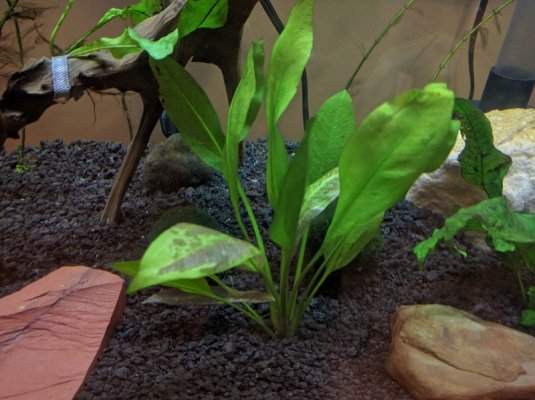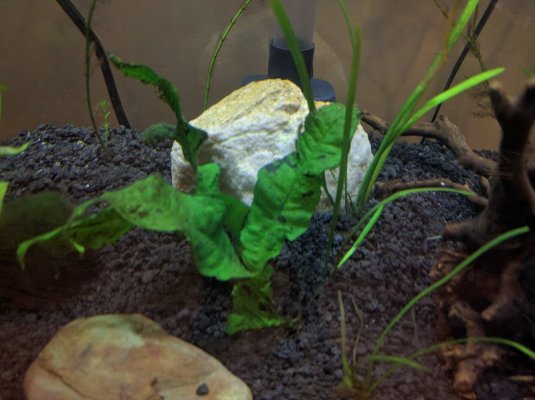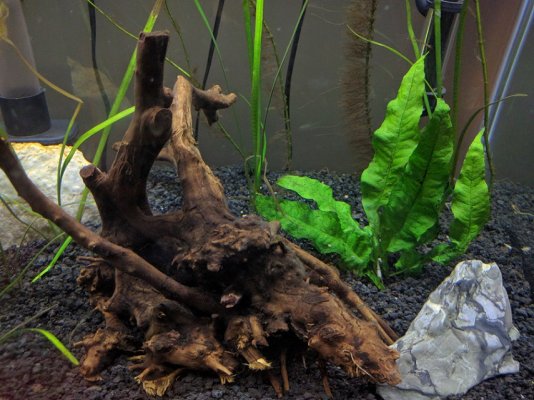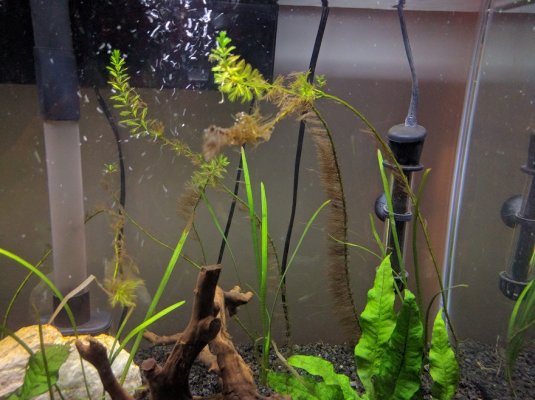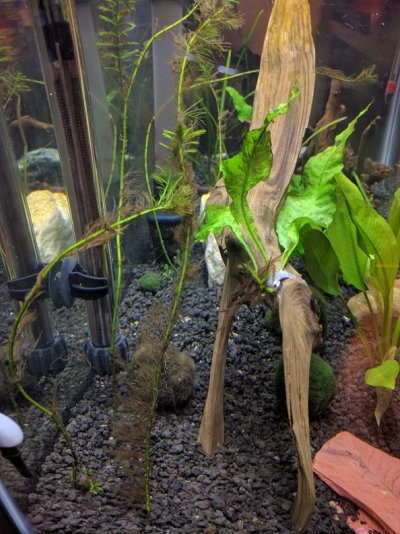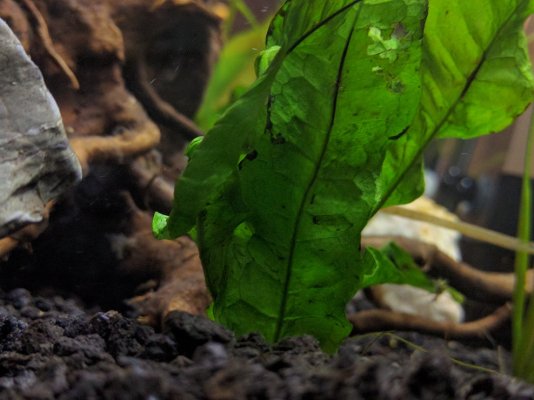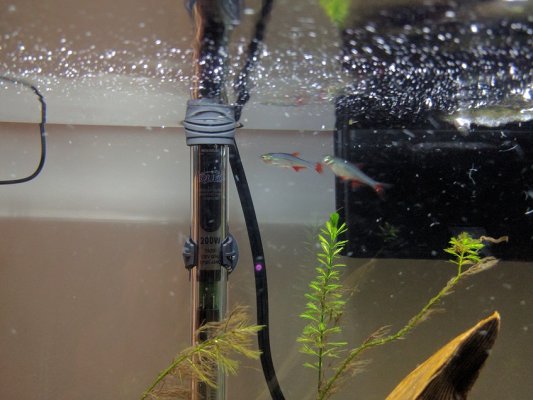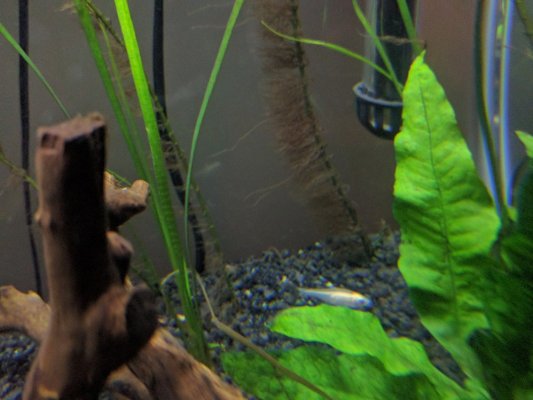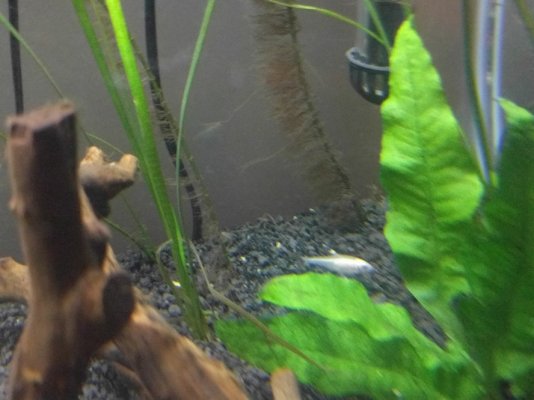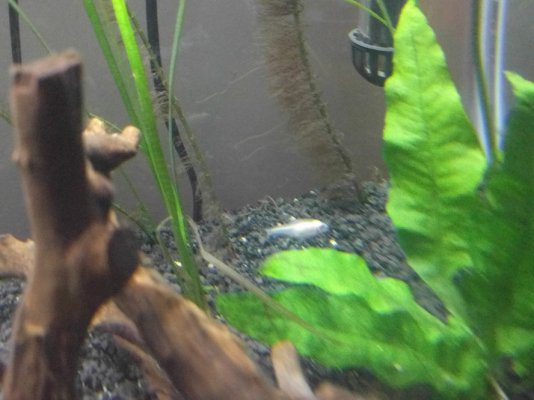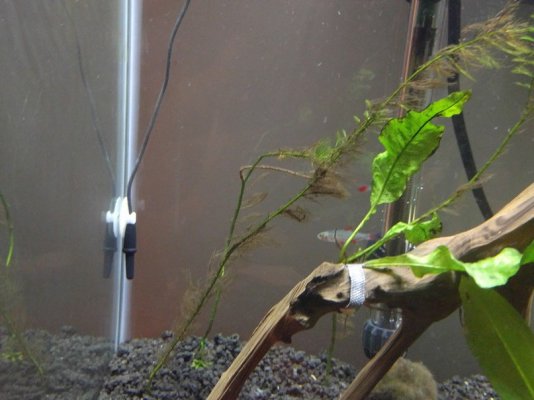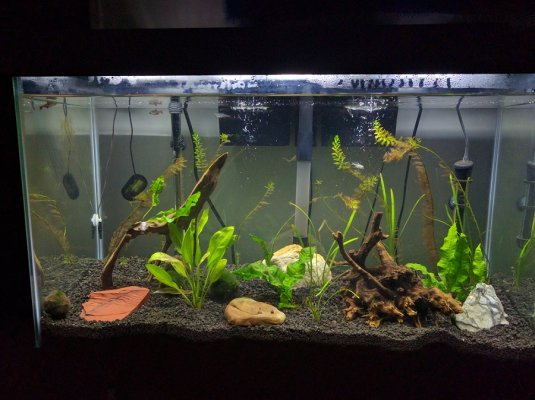I started out with a fishless cycle and within 3 weeks the tank was completely cycled. I used Eco-Complete substrate and re-used old rocks and an old piece of driftwood, both unused for over 20 years but I boiled them for over an hour and dried them completely a few days before putting the tank together. I cleaned the tank and filter, along with purchasing new filter media. We also had LED lights that came in the kit.
The tank was fully cycled for several weeks before adding any fish or plants, we got too busy to get to the fish store to pick out some fish or plants otherwise I would have purchase plants while establishing the cycle. I did get a Morimo Moss ball which we put in during the cycling.
So the tank was fully cycled for 2-3 weeks (testing multiple times a week) then we went to the fish store (Sept. 5th) bought and added two Java Ferns, Sagittaria subulata, Bacopa caroliniana, Dwarf Amazon Swords and something we forgot the name of but they are very tall with frauns similar to the Hornwort.
The same day we also brought with 6 bloodfin tetras and 6 X-Ray Tetras and a yo-yo loach, then went back and bought a second one we also purchase another piece of driftwood (which i boiled for an hour or so).
After struggling with the plants for a few day to get them to stay in place everything was ok for a few weeks then the plants started to look brownish and melting.
Now as far as the fish....
(Sept. 5th) We bought all the fish and one yo-yo loach then I went a bought another yo-yo loach because I read they needed to be in a small group. Then I found a tank stock calculator and they appeared to be taking 25% of my stocking level because they potentially could grow up to 6" despite what the guy at the fish store told us (old hippe guy) so we took them back, however one of the loaches died before I could return them, they gave me a credit without testing my water.
(Sept. 8th) I purchased a few more X-Ray tetras because i thought we bought 5 but actually had 6 so ended up with 7. After I went to Petco and got 3 Amano shrimp to add to the tank to help with algea, only got 3 just in case they didn't last.
I noticed that during the first 3 weeks after adding the driftwood we bought at the store it started growing this blue-green algea (almost looked like mold) on it, so another reason to have the amano shrimp but they appeared not to eat any of it? At this time I noticed a sickly X-Ray swimming near the top with what looked like gaping scar, it died that evening and I scoped it out. Ileaving them to 6)
Before we stocked the tank I did a 80-90% water change the several hours before we stocked the tank. Then I tested the water several times, without any issues other than the pH level was high 8.0-8.4. I went 2 weeks without a water change to try and get the pH down and started doing weekly changes.
3rd week of Sept.The algea on the driftwood slowly turned brownish and went away mostly, but still have grown on it (no longer blueish-green), the amano shrimp started dying right away. I replaced two and then the three were ok for awhile then another one died, then a second on and I lost the 3rd. But one day a week later I saw a third that seemed to last at least another 2 weeks but then died along with another X-Ray Tetra (which I thought was leaving it to 5, but then noticed another one was gone but no body or any trace)
First & second week of October
Last I lost a bloodfin or two(?) and now tonight (10/17) I scoped out a freshly dead Bloodfin and X-Ray. I noticed during the cold spell we had here in MD that the tank temp went way down to 74 and the fish appeared to not be happy, they huddled near the heater and didn't appear to eat at all. I quickly ordered a new heater 200watt Aqueon to supliment the 100Watt generic one that came with the kit. This appeared to make a huge difference as not the temp is stable at 80 (actually 81, so I unplugged the small heater and turned the large one all the way down.
After the temperature change the fish seem to be happier, or at least more active and less huddling. They always seem to hide when I go to feed them or change the tank but now they are more bold.
I've lost count at this point and definitely didn't know when they all died as some appear to have just vanished, but right now I'm down to 3 (Maybe 4 Bloodfins) and 1 X-Ray.
I've done 25-30% water changes every week, along with testing the water twice a week and I get virtually the same results every time with little to no variations other than Nitrates being higher at the end of the week:
Ammonia: 0
Nitrites: 0
pH: 8.0-8.2 (seems to have stabilized at 8.0)
Nitrates: 10-20 ppm (higher right before the water change)
I thought I had this all under control and had pour over these threads and many other online resources for hours/days before buying fish. Now I'm just a bit lost and concerned about spending more money on Fish, between fish and plants we've invested $80.
Also, I feed them a pinch of food twice a day (the bloodfins always seem to eat fine but the X-rays always stay at the bottom and feed what comes to them, but now have gotten more bold)
My question is, is it me? or are they just un-healthy fish from the store?
What else do I need to be testing here? I am not adding any nutrients or anything to help boost the plants. I also am only using the LEDs that came with the tank kit, we were only interested in dealing with low light plants for now. Then when we are comfortable, invest in grow lights and CO2 in the future.
At this point I'm affraid to buy anything else, plants or fish but i don't want to leave the X-ray by itself.
I realize this is a lot to digest and there are many questions, but any please help. Really losing my momentum here on this tank, but I don't want to give up now after seeing some plant growth! But it's puzzling that all the fish having been dying off one by one.
My thoughts were the pH is too high for the shrimp, as they will shed and then die off. I then thought the temp was too low.
The tank was fully cycled for several weeks before adding any fish or plants, we got too busy to get to the fish store to pick out some fish or plants otherwise I would have purchase plants while establishing the cycle. I did get a Morimo Moss ball which we put in during the cycling.
So the tank was fully cycled for 2-3 weeks (testing multiple times a week) then we went to the fish store (Sept. 5th) bought and added two Java Ferns, Sagittaria subulata, Bacopa caroliniana, Dwarf Amazon Swords and something we forgot the name of but they are very tall with frauns similar to the Hornwort.
The same day we also brought with 6 bloodfin tetras and 6 X-Ray Tetras and a yo-yo loach, then went back and bought a second one we also purchase another piece of driftwood (which i boiled for an hour or so).
After struggling with the plants for a few day to get them to stay in place everything was ok for a few weeks then the plants started to look brownish and melting.
- The Java ferns started to get black spots and shrivel a little but are still alive.
- The Sagittaria is doing OK, some of the leaves went brown and died but mostly they have survived.
- The Bacopa caroliniana would never stay put and always came out of the substrate (But these never had any roots, but a bare stem so I never saw how it could root, nor did they) They all went brown and melted so I got rid of them.
- The Dwarf Amazon Swords are getting pale and a few of the stems and leaves have died but they are still surviving just much paler.
- The tall plant (looks like a hornwort but taller) have turned brown and melted from the bottom up but the tops are still green and look ok, however I did remove a few because they were gone. Now after a few weeks of this they have little growths coming up from the stem so that seems positive!
Now as far as the fish....
(Sept. 5th) We bought all the fish and one yo-yo loach then I went a bought another yo-yo loach because I read they needed to be in a small group. Then I found a tank stock calculator and they appeared to be taking 25% of my stocking level because they potentially could grow up to 6" despite what the guy at the fish store told us (old hippe guy) so we took them back, however one of the loaches died before I could return them, they gave me a credit without testing my water.
(Sept. 8th) I purchased a few more X-Ray tetras because i thought we bought 5 but actually had 6 so ended up with 7. After I went to Petco and got 3 Amano shrimp to add to the tank to help with algea, only got 3 just in case they didn't last.
I noticed that during the first 3 weeks after adding the driftwood we bought at the store it started growing this blue-green algea (almost looked like mold) on it, so another reason to have the amano shrimp but they appeared not to eat any of it? At this time I noticed a sickly X-Ray swimming near the top with what looked like gaping scar, it died that evening and I scoped it out. Ileaving them to 6)
Before we stocked the tank I did a 80-90% water change the several hours before we stocked the tank. Then I tested the water several times, without any issues other than the pH level was high 8.0-8.4. I went 2 weeks without a water change to try and get the pH down and started doing weekly changes.
3rd week of Sept.The algea on the driftwood slowly turned brownish and went away mostly, but still have grown on it (no longer blueish-green), the amano shrimp started dying right away. I replaced two and then the three were ok for awhile then another one died, then a second on and I lost the 3rd. But one day a week later I saw a third that seemed to last at least another 2 weeks but then died along with another X-Ray Tetra (which I thought was leaving it to 5, but then noticed another one was gone but no body or any trace)
First & second week of October
Last I lost a bloodfin or two(?) and now tonight (10/17) I scoped out a freshly dead Bloodfin and X-Ray. I noticed during the cold spell we had here in MD that the tank temp went way down to 74 and the fish appeared to not be happy, they huddled near the heater and didn't appear to eat at all. I quickly ordered a new heater 200watt Aqueon to supliment the 100Watt generic one that came with the kit. This appeared to make a huge difference as not the temp is stable at 80 (actually 81, so I unplugged the small heater and turned the large one all the way down.
After the temperature change the fish seem to be happier, or at least more active and less huddling. They always seem to hide when I go to feed them or change the tank but now they are more bold.
I've lost count at this point and definitely didn't know when they all died as some appear to have just vanished, but right now I'm down to 3 (Maybe 4 Bloodfins) and 1 X-Ray.
I've done 25-30% water changes every week, along with testing the water twice a week and I get virtually the same results every time with little to no variations other than Nitrates being higher at the end of the week:
Ammonia: 0
Nitrites: 0
pH: 8.0-8.2 (seems to have stabilized at 8.0)
Nitrates: 10-20 ppm (higher right before the water change)
I thought I had this all under control and had pour over these threads and many other online resources for hours/days before buying fish. Now I'm just a bit lost and concerned about spending more money on Fish, between fish and plants we've invested $80.
Also, I feed them a pinch of food twice a day (the bloodfins always seem to eat fine but the X-rays always stay at the bottom and feed what comes to them, but now have gotten more bold)
My question is, is it me? or are they just un-healthy fish from the store?
What else do I need to be testing here? I am not adding any nutrients or anything to help boost the plants. I also am only using the LEDs that came with the tank kit, we were only interested in dealing with low light plants for now. Then when we are comfortable, invest in grow lights and CO2 in the future.
At this point I'm affraid to buy anything else, plants or fish but i don't want to leave the X-ray by itself.
I realize this is a lot to digest and there are many questions, but any please help. Really losing my momentum here on this tank, but I don't want to give up now after seeing some plant growth! But it's puzzling that all the fish having been dying off one by one.
My thoughts were the pH is too high for the shrimp, as they will shed and then die off. I then thought the temp was too low.

